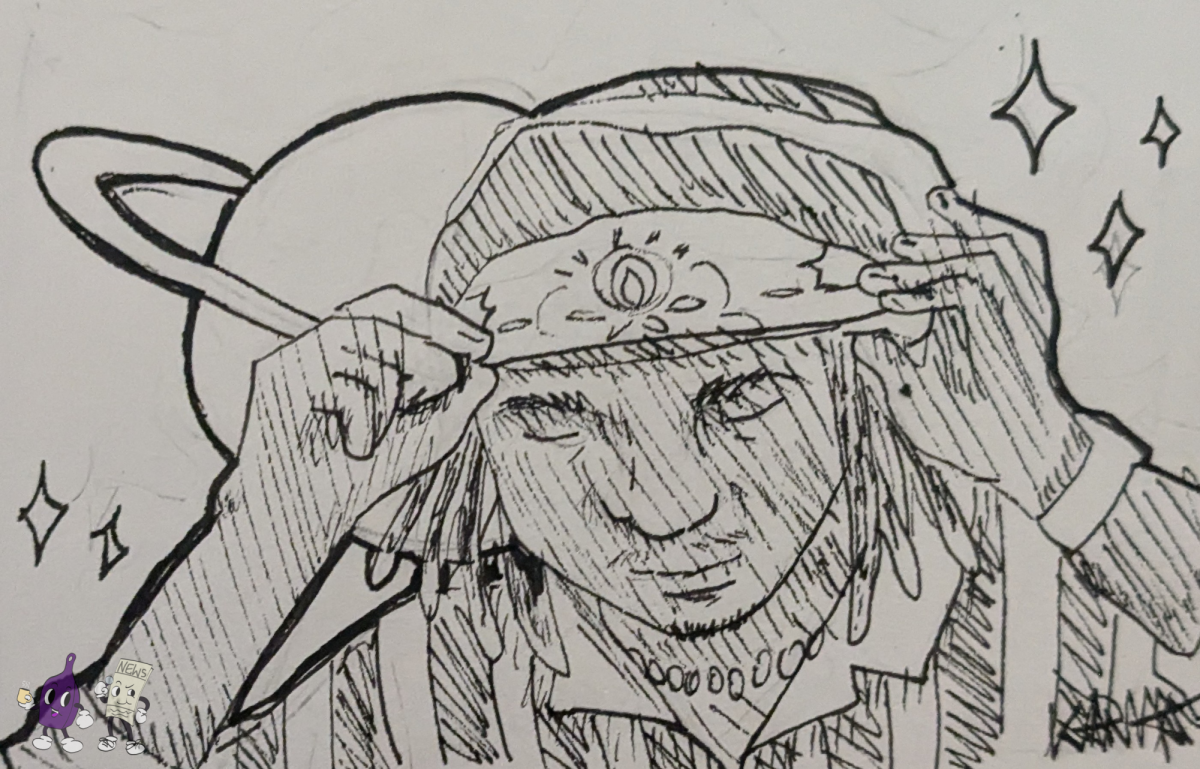Searching for a music video by South African enigmatic underground rap icon fuccory (Cory hereafter) yields only a singular result. In this video, camcorder footage is played of the rapper consuming obscene amounts of marijuana outside of a gas station while he stares at a fleet of police officers. As a whispering chorus of collected “let’s go, bro” and “get outta here” flutters in the background, Cory remains completely stagnant, moving exclusively to exhale a wispy plume of smoke towards the red and blue lights.
At the time, any cannabis consumption in public was a criminal offense, especially prosecuted by the police in individuals with darker skin. This scene, as we watch Cory and friends from behind in night-vision monochrome exhaling gauzy streams of smoldering vapor and ash into the faces of police officers, perfectly encapsulates the concept that the South African underground rage rap scene has developed for the past half-decade: authority is undeserving of respect (or, at least, worth questioning).
When we understand this, a very profound community and mutual respect emerges.
This ideology is certainly controversial, but it is undeniably impressive how thoroughly it is incorporated in South African underground rage rap (the national scene within which artists like fuccory create). However, in order to approach that topic, we must first get an understanding of the genre that will be referred to in this article as South African underground rap.
The foundation of South African underground rap is drum tracks completely void of trap sounds or live percussion, opting instead for loud dry blips of noise that pass for cymbals and claps. The melodies often consist of a handful of jittery, raw digital synths blown to absolute hell and diluted under layers of softclippers and saturators.
Toplines stutter and trip over themselves, as if even they are too intimidated to make noise. Occasionally, you’ll hear a drum track fully disappear in the midst of a song to give room for a burst gunfire noise, or a scream, or a tape stop that drags the beat to a grinding halt.
When drums are present, the claps (if they can even be described as claps) are seemingly littered throughout the entirety of the drum line and looped ad nauseum – or at least until they randomly begin to reverse and distort.
The strange and eerie sonic qualities of the South African underground scene are definitely different from any other musical scene, but the music is unmistakably distinct for a variety of reasons. The unease that soaks South African underground rage rap music certainly creates a distinct atmosphere. However, it is also utilized to create a portrait of the racial tension that pollutes apartheid and post-apartheid South Africa.
By 1994, directly succeeding the age of the horrific and segregated regime of apartheid, South African racial tension had only continued to spread around the nation. While the illegalization of interracial coexistence had been demolished, the divides that had been created by decades of discrimination had not. Furthermore, governmental institutions still quietly upheld white supremacist ideologies, evidenced by the wave of South African police brutality that occurred directly after 1990’s first efforts towards apartheid annulment.
This tension – and discussions of this tension – has become widely prevalent in the art of South Africa (and Africa as a whole), with songs about liberty and hatred garnering international acclaim. However, this music is a major utility to bring people together.
Speaking particularly of South African underground rap, gender roles, racial bias, and general preconceptions are wholly shattered. A variety of skin tones create underground rap internationally, and that is especially truthful examining the South African underground scene. South African women who rap are certainly not scarce, nor are they regarded as artistically inferior to their male peers – among the most revered of South African underground artists are woman titans Scumie, vamphail3y, and rati$upremacy.
In every way, ideas of femininity and masculinity – or, rather, of the incommunicability and absolute differences between the masculine and the feminine – are immediately discarded. A beautiful demonstration of this is producer/rapper megatitan BrotherKupa’s song “All About Daht”. The song features, as is somewhat typical in South African underground rap, squealing rap-whines about grievous acts of murder and deep-rooted dissidence.
What is particularly interesting about the song is the beat that he does this over. At the forefront of the instrumental is a frenetic chop of “girl-pop” legend Meghan Trainor’s classic “All About That Bass”, as well as a dizzying, elastic sub bass underlining Trainor’s twangy pop-leaning voice with dread and unease. The “girly” nature of the sample does not detract from the frightening and uneasy nature of “All About Daht”.
The gender norms that we assign to music, or culture, or even people, are completely irrelevant in this song to the message and mood that are created. This lack of significance that is ascribed to gender creates, weirdly, a unity – which is not something that can be said of most anti-establishmentarian digital punk rap. This unity, however, while being extremely profound in the South African underground, is centered around dissidence and vigorous self-defense.
Approaching unity through dissidence, while being undeniably controversial, is thoroughly interesting to witness. It is even more interesting – and invigorating – to see unity be promoted in music that youth genuinely enjoy and consume. In an age where popular music has become a space predominantly featuring songs that present division or distrust more than anything, it is refreshing to see a take on that music that intends to create unity between people.
Whether that unity is the most morally sound can certainly be questioned, but there is no doubt that the South African underground rage rap scene is among the most curious and innovative music genres today- and if South African underground rap is what inspires a generation of children to work to fight against corruption both within South Africa and in international communities, it should, within reason, be celebrated.




